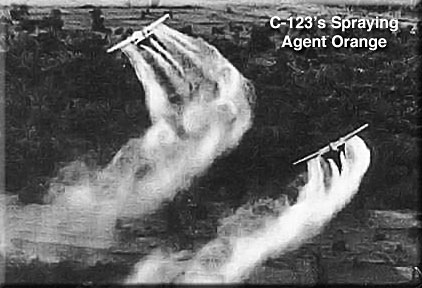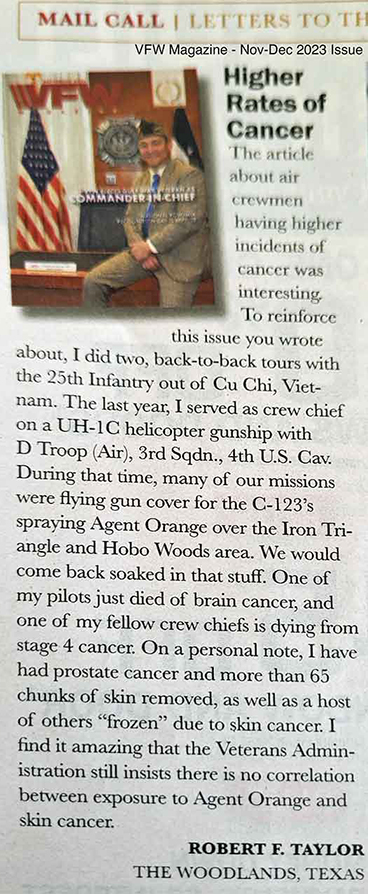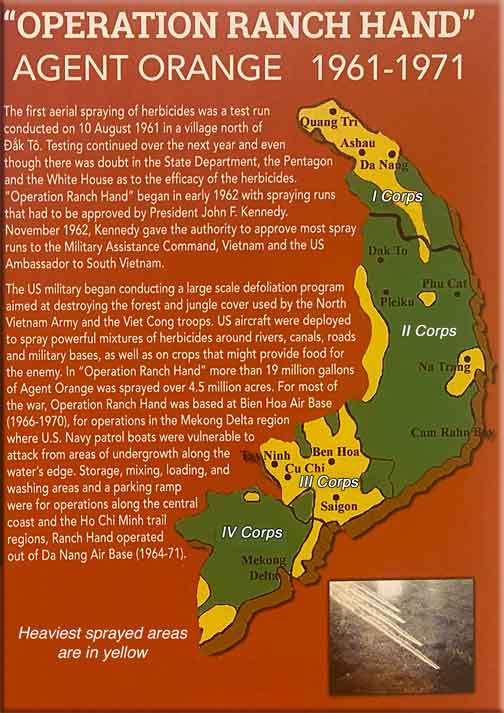

Pat Eastes, Tom Meeks, Jack Nemeyer, Bob Taylor, Rick Williams, Larry Patterson
……………………………………………………………………………………………………………………………………
 Agent Orange was a powerful mixture of chemical defoliants used by U.S. military forces during the Vietnam War to eliminate forest cover for North Vietnamese and Viet Cong troops, as well as crops that might be used to feed them. The U.S. program of defoliation, codenamed Operation Ranch Hand, sprayed more than 19 million gallons of herbicides over 4.5 million acres of land in Vietnam from 1961 to 1972. Agent Orange, which contained the chemical dioxin, was the most commonly used of the herbicide mixtures, and the most effective. It was later revealed to cause serious health issues–including tumors, birth defects, rashes, psychological symptoms and cancer–among returning U.S. servicemen and their families as well as among the Vietnamese population.
Agent Orange was a powerful mixture of chemical defoliants used by U.S. military forces during the Vietnam War to eliminate forest cover for North Vietnamese and Viet Cong troops, as well as crops that might be used to feed them. The U.S. program of defoliation, codenamed Operation Ranch Hand, sprayed more than 19 million gallons of herbicides over 4.5 million acres of land in Vietnam from 1961 to 1972. Agent Orange, which contained the chemical dioxin, was the most commonly used of the herbicide mixtures, and the most effective. It was later revealed to cause serious health issues–including tumors, birth defects, rashes, psychological symptoms and cancer–among returning U.S. servicemen and their families as well as among the Vietnamese population.
Pat Eastes: I can remember flying gun cover on defoliation missions a time or two, flying as fast as we could behind a C123 that was spraying agent orange, to supposedly 'cover' his back. I seem to recall that we wore gas masks when we did it. Am I hallucinating? The memory is vague at best, so maybe I'm all wrong on this, Anybody that remembers what we really did on those missions, please chime in. I have had several skin cancers removed over the years, and have had prostate cancer since 2018. I agree with Bob that the VA is derelict in not including some skin cancers as Agent Orange related. Note that just being on the ground in VN exposed you to Agent Orange.
Tom Meeks: Like Pat, I remember flying missions chasing a C123 while he was spraying areas with agent orange. We did have masks with us just in case and most of the time we wore them because the aircraft was drenched with that stuff. Remember after the mission of covering for them, we used to slip the aircraft to get fresh air into the aircraft and the get agent orange out. I really don’t remember ever having to shoot at anything when doing one of those missions.
 Jack Nemeyer: This is near KATUM (Tien Yan or Tien Xon?)....another POL point near the Cambodian Border.....A half assed Fire base or Logger site....We got over sprayed with Agent Orange here several times....Spent many hours here waiting for missions....
Jack Nemeyer: This is near KATUM (Tien Yan or Tien Xon?)....another POL point near the Cambodian Border.....A half assed Fire base or Logger site....We got over sprayed with Agent Orange here several times....Spent many hours here waiting for missions....
This POL was operated by a small lawnmower engine powering a small pump, pumping from large rubber fuel bladders... The more aircraft thatwere fueling the longer it took to top off !! The fuel just dribbled out of the nozzle.
This POL also had a short runway for Fixed Wings... The problem with being over sprayed , besides the obvious.... Is the spray has a "sticker" applied or mixed in to help stick it to the foliage . Once you are over sprayed it's hard to get it off !
I know at Katum where we waited for hours for missions, we took our shirts off, hung out doing maint. and cleaning weapons, sleepin , you know "normal" activities. Those AF C-123's would come in low over the tree tops and dump on us !! That Sticky Spray was on you the rest of the day or longer ! We got the bright idea of jumping into
one of the many flooded bomb craters and taking a bath, (no soap.....) Problem was the Bomb Craters were over sprayed too !! but at least we weren't so sticky... Showers at CuChi were a welcome sight, but more often than not the water tanks were empty because the water truck driver spent his time in CuChi City at the whore houses !!!
Larry Patterson: I can remember flying OH23s as an After Action Report to determine the effectiveness of spraying.
Bob Taylor: Speaking for the guys in the back, I know we were issued gas masks for those spraying missions. I also remember not being able to use them because we couldn’t get them to fit under our flight helmets and even if we did manage to get it on, you couldn’t talk on the radio. The crew chiefs and gunners took a beating. We would come back drenched in that crap. I think I remember the pilots “crabbing” the ship from one side to the other trying to give each of us a temporary break. I have had in excess of 40 bouts of skin cancer, almost all of it on my face, neck and upper chest, the area most exposed to the stuff during those flights.

Rick Williams points out that there is a map like this at the National Vietnam War Museum
